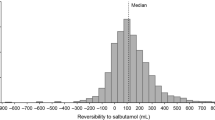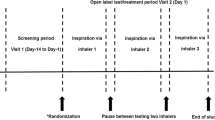Abstract
Background
This study compares the effect of heliox-driven to that of air-driven bronchodilator therapy on the pulmonary function test (PFT) in patients with different levels of asthma severity.
Methods
One-hundred thirty-two participants were included in the study. Participants underwent spirometry twice with bronchodilator testing on two consecutive days. Air-driven nebulization was used one day and heliox-driven nebulization the other day in random order crossover design. After a baseline PFT, each participant received 2.5 mg of albuterol sulfate nebulized with the randomized driving gas. Post bronchodilator PFT was repeated after 30 min. The next day, the exact same protocol was repeated, except that the other driving gas was used to nebulize the drug. Participants were subgrouped and analyzed according to their baseline FEV1 on day 1: Group I, FEV1 ≥80 %; Group II, 80 % > FEV1 > 50 %; Group III, FEV1 ≤50 %. The proportion of participants with greater than 12 % and 200-mL increases from their baseline FEV1 and the changes from baseline in PFT variables were compared between heliox-driven versus air-driven bronchodilation therapy.
Results
The proportion of participants with >12 % and 200-mL increases from their baseline FEV1 with air- or heliox-driven bronchodilation was not different with respect to the proportion of participants with baseline FEV1 ≥80 % (20 vs. 18 %, respectively) and 80 % > FEV1 > 50 % (36 vs. 43 %, respectively), but it was significantly greater with heliox-driven bronchodilation in participants with FEV1 ≤50 % (43 vs. 73 %, respectively; p = 0.01). Changes from baseline FVC, FEV1, FEV1/FVC, FEF25–75 %, FEFmax, FEF25 %, FEF50 %, and FEF75 % were significantly larger with heliox-driven versus air-driven bronchodilation in participants with baseline FEV1 ≤50 %.
Conclusion
Improvements in PFT variables are more frequent and profound with heliox-driven compared to air-driven bronchodilator therapy only in asthmatic patients with baseline FEV1 ≤50 %.

Similar content being viewed by others
References
Svartengren K, Lindestad PA, Svartengren M, Bylin G, Philipson K, Camner P (1994) Deposition of inhaled particles in the mouth and throat of asthmatic subjects. Eur Respir J 7(8):1467–1473
Darquenne C, Prisa GK (2004) Aerosol deposition in the human respiratory tract breathing air and 80:20 heliox. J Aerosol Med 17(3):278–285
Ho AM, Lee A, Karmakar MK, Dion PW, Chung DC, Contardi LH (2003) Heliox vs air-oxygen mixtures for the treatment of patients with acute asthma: a systematic overview. Chest 123(3):882–890
Ari A, Fink JB (2010) Aerosol drug delivery administration with helium:oxygen (heliox) mixtures: an overview. Curr Respir Med Rev 6:80–85
Wright RB, Rowe BH, Arent RJ, Klassen TP (2005) Current pharmacological options in the treatment of croup. Expert Opin Pharmacother 6(2):255–261
Andrews R, Lynch M (2004) Heliox in the treatment of chronic obstructive pulmonary disease. Emerg Med J 21(6):670–675
Palange P, Crimi E, Pellegrino R, Brusasco V (2005) Supplemental oxygen and heliox: ‘new’ tools for exercise training in chronic obstructive pulmonary disease. Curr Opin Pulm Med 11(2):145–148
Alcoforado L, Brandao S, Rattes C, Brandao D, Lima V, Ferreira-Lima G, Fink J, Dornelas de Andrade A (2013) Evaluation of lung function and deposition of aerosolized bronchodilators carried by heliox associated with positive expiratory pressure in stable asthmatics: A randomized clinical trial. Respir Med 107:1178–1185
Bag R, Bandi V, Fromm RE Jr, Guntupalli K (2002) The effect of heliox-driven bronchodilator aerosol therapy on pulmonary function tests in patients with asthma. J Asthma 39(7):659–665
Bandi V, Velamuri S, Sirgi C, Wendt J, Wendt R, Guntupalli (2005) Deposition pattern of heliox-driven bronchodilator aerosol in the airways of stable asthmatics. J Asthma 42(7):583–586
Kress JP, Noth I, Gehlbach BK, Barman N, Pohlman AS, Miller A, Morgan S, Hall JB (2002) The utility of albuterol nebulized with heliox during acute asthma exacerbations. Am J Respir Crit Care Med 165(9):1317–1321
American Thoracic Society (1995) Standards for the diagnosis and care of patients with chronic obstructive pulmonary disease. Am J Respir Crit Care Med 152(5 Pt 2):S77–S121
Morris J, Koski A, Johnson L (1971) Spirometric standards for healthy nonsmoking adults. Am Rev Respir Dis 103(1):57–67
Morris J, Koski A, Temple W, Claremont A, Thomas D (1988) Fifteen-year interval spirometric evaluation of the Oregon predictive equations. Chest 93(1):123–127
Cherniack R, Raber M (1972) Normal standards for ventilatory function using an automated wedge spirometer. Am Rev Respir Dis 106:38–46
Bumbacea D, Campbell D, Nguyen L, Carr D, Barnes P, Robinson D, Chung K (2004) Parameters associated with persistent airflow obstruction in chronic severe asthma. Eur Respir J 24(1):122–128
Papamoschou D (1995) Theoretical validation of the respiratory benefits of helium-oxygen mixtures. Respir Physiol 99(1):183–190
Corcoran TE, Gamard S (2004) Development of aerosol drug delivery with helium oxygen gas mixtures. J Aerosol Med 17(4):299–309
Piva J, Menna Barreto S, Zelmanovitz F, Amantéa S, Cox P (2002) Heliox versus oxygen for nebulized aerosol therapy in children with lower airway obstruction. Pediatr Crit Care Med 3:6–10
Lee DL, Hsu CW, Lee H, Chang HW, Huang YC (2005) Beneficial effects of albuterol therapy driven by heliox versus by oxygen in severe asthma exacerbations. Acad Emerg Med 12(9):820–827
Colebourn C, Barber V, Young J (2007) Use of helium-oxygen mixture in adult patients presenting with exacerbations of asthma and chronic obstructive pulmonary disease: a systematic review. Anaesthesia 62:34–42
Henderson SO, Acharya P, Kilaghbian T, Perez J, Korn CS, Chan LS (1999) Use of heliox-driven nebulizer therapy in the treatment of acute asthma. Ann Emerg Med 33(2):141–146
Dorfman TA, Shipley ER, Burton JH, Jones P, Mette SA (2000) Inhaled heliox does not benefit ED patients with moderate to severe asthma. Am J Emerg Med 18(4):495–497
Rose JS, Panacek EA, Miller P (2003) Prospective randomized trial of heliox-driven continuous nebulizers in the treatment of asthma in the emergency department. J Emerg Med 116(Suppl):1011–1015
Rivera ML, Kim TY, Stewart GM, Minasyan L, Brown L (2006) Albuterol nebulized in heliox in the initial ED treatment of pediatric asthma: a blinded, randomized controlled trial. Am J Emerg Med 24(1):38–42
Brandão DC, Britto MC, Pessoa MF, de Sa RB, Alcoforado L, Matos LO, Silva TN, de Andrade AD (2011) Heliox and forward-leaning posture improve the efficacy of nebulized bronchodilator in acute asthma: a randomized trial. Respir Care 56(7):947–952
Pecchiari M, Pelucchi A, D’Angelo E, Forest A, Milic-Emili J, D’Angelo E (2004) Effect of heliox breathing on dynamic hyperinflation in COPD patients. Chest 125(6):2075–2082
Palange P, Valli G, Onorati P, Antonucci R, Paoletti P, Rosato A, Manfredi F, Serra P (2004) Effect of heliox on lung dynamic hyperinflation, dyspnea, and exercise endurance capacity in COPD patients. J App Physiol 97(5):1637–1642
Eves N, Petersen S, Haykowsky M, Wong E, Jones R (2006) Helium-hyperoxia, exercise, and respiratory mechanics in chronic obstructive pulmonary disease. Am J Respir Crit Care Med 174(7):763–771
Acknowledgments
The authors acknowledge the help of Ms. Juliette Jibrail and Ms. Lina Itani, Technologist in the Pulmonary Function Laboratory, as well as the staff of the Inhalation Therapy Department at the American University of Beirut Medical Center.
Conflict of interest
None.
Author information
Authors and Affiliations
Corresponding author
Rights and permissions
About this article
Cite this article
El-Khatib, M.F., Jamaleddine, G., Kanj, N. et al. Effect of Heliox- and Air-Driven Nebulized Bronchodilator Therapy on Lung Function in Patients with Asthma. Lung 192, 377–383 (2014). https://doi.org/10.1007/s00408-014-9570-0
Received:
Accepted:
Published:
Issue Date:
DOI: https://doi.org/10.1007/s00408-014-9570-0




